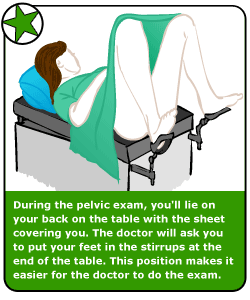What Is a Pelvic Exam?
A pelvic exam is where a doctor or nurse practitioner looks at a girl's reproductive organs (both outside and internally). This includes feeling a girl's uterus and ovaries to be sure everything's normal.
Teens don't usually get pelvic exams. Sometimes doctors do pelvic exams if they think there's a problem. For example, if a girl complains of heavy bleeding, missed periods, or discharge, the doctor will want to check for a cause. Otherwise, doctors don't recommend regular pelvic exams or Pap smears until a woman is 21 years old.
What Happens During a Pelvic Exam?
A medical assistant or nurse will give you a robe to wear and a sheet to cover you. You'll be left alone to undress — either fully (if you're getting a breast exam as well) or from the waist down.
The doctor or nurse practitioner will come into the room and talk a bit about what to expect and why they're doing the exam. Then, you'll lie on the table so your behind is at the end of the table. You'll bend your knees and rest your feet in two stirrups, which are metal triangular loops that stick out from the end of the table. These might look a little scary, but they're just there to rest your feet in and keep you more comfortable.

The doctor will ask you to relax your knees out to the sides as far as they will go. It might feel a little funny to be lying with your legs opened like this, but everyone feels that way at first.
The doctor will put on gloves and examine the outside of your vagina to make sure that there are no sores or swelling and that everything looks OK on the outside.
The Internal Exam
The doctor will want to look at the inside of your vagina. She or he will use a speculum to gently widen the vagina. A speculum is a thin piece of plastic or metal with a hinged piece on one end that allows it to open and close. If the speculum is metal, the doctor or nurse will warm it to make it more comfortable. The doctor or nurse will let you know just before putting the speculum in your vagina.
Once the speculum is in place, the doctor or nurse will gently open it up. Putting in and opening the speculum shouldn't hurt. But some women say that it can cause a bit of pressure and discomfort.
Because the vagina is surrounded by muscles that can contract or relax, the exam can be more comfortable if you relax the muscles in that area. Try doing some breathing exercises or focusing on relaxing the vaginal muscles. Sometimes humming your favorite song or chatting to the doctor or nurse can distract you and help you feel more relaxed.
After the speculum is in place, the doctor or nurse practitioner will shine a light inside the vagina to look for anything unusual, like redness, swelling, discharge, or sores. The doctor may quickly wipe a cotton swab inside the vagina to collect a sample of mucus in order to test for infection, if necessary. The doctor or nurse will slide the speculum out as soon as the exam is done. This part of the exam only takes a minute or two.
The ovaries and uterus are so far inside a girl's body that they can't be seen — even using a speculum. The doctor or nurse will need to feel them to be sure they're the right size and free of cysts or other growths.
For this part of the exam, you'll keep your feet in the stirrups. The doctor or nurse will put lubricant on two fingers (still wearing the gloves) and slide them inside your vagina. Using the other hand, he or she will press on the outside of your lower abdomen (the area between your vagina and your stomach). You may feel a little pressure or discomfort. Again, it can help to relax your muscles and take slow, deep breaths.
The entire pelvic exam takes about 3 to 5 minutes.
Making the Appointment
It's best to schedule the exam for a time when you won't have your period, but that can be hard to predict because lots of girls have irregular periods at first. When you make the appointment, ask what to do if you get your period when you're supposed to come for your exam. Most doctors say it's OK to come for an exam during your period, so don't worry about that at all.
Your first pelvic exam can be a bit of a shock, but it helps to remember that each time it gets easier and easier to relax. No one loves the exam, but having a doctor or nurse practitioner you trust can really help.


